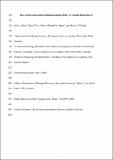Files in this item
Does social environment influence learning ability in a family-living lizard?
Item metadata
| dc.contributor.author | Riley, Julia L | |
| dc.contributor.author | Noble, Daniel W A | |
| dc.contributor.author | Byrne, Richard William | |
| dc.contributor.author | Whiting, Martin J | |
| dc.date.accessioned | 2017-12-27T00:34:06Z | |
| dc.date.available | 2017-12-27T00:34:06Z | |
| dc.date.issued | 2017-05 | |
| dc.identifier | 248219921 | |
| dc.identifier | 9476bea2-c426-4bd9-b7f1-3f2a1e575af5 | |
| dc.identifier | 85007153015 | |
| dc.identifier | 000399695800008 | |
| dc.identifier.citation | Riley , J L , Noble , D W A , Byrne , R W & Whiting , M J 2017 , ' Does social environment influence learning ability in a family-living lizard? ' , Animal Cognition , vol. 20 , no. 3 , pp. 449-458 . https://doi.org/10.1007/s10071-016-1068-0 | en |
| dc.identifier.issn | 1435-9448 | |
| dc.identifier.other | ORCID: /0000-0001-9862-9373/work/60630513 | |
| dc.identifier.uri | https://hdl.handle.net/10023/12386 | |
| dc.description | Financial support for this research was provided by the Australian Research Council (DP130102998, awarded to MJW and RWB), Natural Sciences and Engineering Research Council of Canada (scholarship to JLR), the Australasian Society for the Study of Animal Behaviour, the Australian Museum, and Macquarie University. DWAN was supported by an ARC Discovery Early Career Research Award (DE150101774) and UNSW Vice Chancellors Fellowship. | en |
| dc.description.abstract | Early developmental environment can have profound effects on individual physiology, behaviour, and learning. In birds and mammals social isolation during development is known to negatively affect learning ability; yet in other taxa, like reptiles, the effect of social isolation during development on learning ability is unknown. We investigated how social environment affects learning ability in the family-living tree skink (Egernia striolata). We hypothesized that early social environment shapes cognitive development in skinks, and predicted that skinks raised in social isolation would have reduced learning ability compared to skinks raised socially. Offspring were separated at birth into two treatments: (1) raised alone, or (2) in a pair. After one year we quantified spatial learning ability of skinks in these treatments (N = 14 solitary, 14 social). We found no effect of treatment on learning ability. The number of skinks to successfully learn the task, the number of trials taken to learn the task, the latency to perform the task, and the number of errors in each trial did not differ between isolated and socially-reared skinks. Our results were unexpected, yet the facultative nature of this species’ social system may result in a reduced effect of social isolation on behaviour when compared to species with obligate sociality. Overall, our findings do not provide evidence that social environment affects development of spatial learning ability in this family-living lizard. | |
| dc.format.extent | 735821 | |
| dc.format.extent | 1017872 | |
| dc.language.iso | eng | |
| dc.relation.ispartof | Animal Cognition | en |
| dc.subject | Squamate | en |
| dc.subject | Sociality | en |
| dc.subject | Cognition | en |
| dc.subject | Ontogeny | en |
| dc.subject | Facultative sociality | en |
| dc.subject | QH301 Biology | en |
| dc.subject | RC0321 Neuroscience. Biological psychiatry. Neuropsychiatry | en |
| dc.subject | DAS | en |
| dc.subject.lcc | QH301 | en |
| dc.subject.lcc | RC0321 | en |
| dc.title | Does social environment influence learning ability in a family-living lizard? | en |
| dc.type | Journal article | en |
| dc.contributor.institution | University of St Andrews. School of Psychology and Neuroscience | en |
| dc.contributor.institution | University of St Andrews. Centre for Social Learning & Cognitive Evolution | en |
| dc.identifier.doi | 10.1007/s10071-016-1068-0 | |
| dc.description.status | Peer reviewed | en |
| dc.date.embargoedUntil | 2017-12-26 | |
| dc.identifier.url | http://link.springer.com/article/10.1007/s10071-016-1068-0#SupplementaryMaterial | en |
This item appears in the following Collection(s)
Items in the St Andrews Research Repository are protected by copyright, with all rights reserved, unless otherwise indicated.


